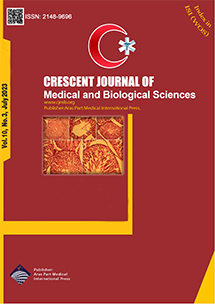

| Original Article | |
| The Effectiveness of Intravenous lidocaine in Burn Pain Relief: A Randomized Double-Blind Controlled Trial | |
| Mohammad Haghighi1, Bahram Naderi Nabi1, Hossein Khoshrang1, Siamak Rimaz1, Soudabeh Haddadi1, Arman Parvizi1, Mohammadreza Mobayen2, Gelareh Biazar1, Tayebeh Zarei3 | |
| 1Anesthesiology Research Center, Department of Anesthesiology, Alzahra Hospital, Guilan University of Medical Sciences , Rasht, Iran 2Burn and Regenerative Medicine Research Center, Guilan University of Medical Sciences, Rasht, Iran 3Critical Care and Pain Management Research Center, Hormozgan University of Medical Sciences, Hormozgan, Iran |
|
|
CJMB 2023; 10: 110-115 DOI: 10.34172/cjmb.2023.18 Viewed : 3116 times Downloaded : 2522 times. Keywords : Burn patient, Intravenous lidocaine, Pain relief |
|
| Full Text(PDF) | Related Articles | |
| Abstract | |
Objectives: Poor pain control in burn patients as a great public health problem disrupts the healing and rehabilitation process and results in several adverse outcomes. The aim of this study was to investigate the efficacy and safety of intravenous lidocaine in reducing the pain of burn injuries. Materials and Methods: From August 2014 to March 2015, 66 eligible burn patients participated in the study and were randomly divided into two groups of lidocaine (L) and placebo (P). In group L, lidocaine 2% was injected at a bolus dose of 1.5 mg/kg followed by infusion at the dosage of 1.5 mg/kg/h, and in group P, saline was administrated. Pain severity was measured during 24 hours at baseline and 1, 2, 4, 8, 12, 16, 20, 24 hours after intervention based on Numerical Rating Scale (NRS-11). Morphine consumption, Ramsay score, and side effects were also documented. Results: Finally the data from 60 patients were analyzed. Comparing baseline with 24 hours after intervention, NRS-11 scores decreased from 7.12±1.42 to 3.33±0.76 (P < 0.001) in group P and from 6.45±1.02 to 2.50±0.72 (P < 0.001) in group L. Moreover, the mean of NRS scores during 24 hours in the lidocaine group was significantly lower compared to the placebo group, 3.93±0.72 vs 4.73 ±1.14, (P = 0.03). The mean amounts of morphine consumption in group L were significantly lower compared to group P, 14.41 ± 4.86 vs 21.07±6.86, (P = 0.001). The mean of Ramsay score in group L was significantly lower compared to group P, 1.38±0.59 vs 1.45±0.6, (P = 0.014). Conclusions: This study revealed that intravenous lidocaine was an effective and safe drug for pain reduction in burn patients. |
Cite By, Google Scholar
Google Scholar
PubMed
Online Submission System
 CJMB ENDNOTE ® Style
CJMB ENDNOTE ® Style
 Tutorials
Tutorials
 Publication Charge
Medical and Biological Research Center
About Journal
Publication Charge
Medical and Biological Research Center
About Journal
Aras Part Medical International Press Editor-in-Chief
Arash Khaki
Deputy Editor
Zafer Akan

















